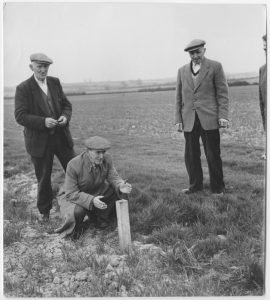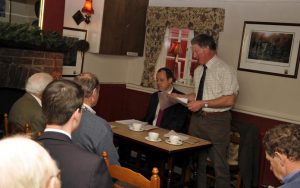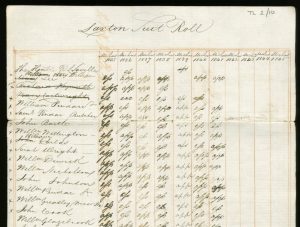August 30, 2022, by Kathryn Steenson
Thoroughly Modern Manor
At first glance the village of Laxton in north Nottinghamshire does not appear unusual. A few miles from the A1, it is surrounded by farmland and has been inhabited for at least 1000 years. It is estimated from Domesday Book that Laxton may have been home to 120 people in 1086. The population was around 350 in 1635, peaking in 1821 with 655. In the 2011 census the population had dropped to 489.
Laxton is also the only place in Europe where open field farming is still practised across a whole village. Such systems date back to medieval times but in most places they were swept away by the process of enclosure. In an open field system, individual farmers cultivate separate strips of land in the fields, which have a strict crop rotation (winter wheat, other cereals, and fallow) that they must all follow.

Photograph of Laxton Jury Day, showing Bailiff Elmar Rose crouching in front of a stake to mark a boundary on the open field, c.1950s
The boundaries between between the strips, roadways and sykes (uncultivated grass areas) are marked by wooden stakes. By sowing the same crops at the same time, the harvest should also be at the same time. After the harvest, animals can then graze the fields.
This detailed plan by Thomas Huskinson from in 1862 is hand-drawn and colour-coded to show the holdings of each of the Earl’s tenants. The colour-coding reveals how the holdings of most farmers were scattered among the open fields and enclosures, and their narrow size and shape is striking. Areas left uncoloured represent other landowners’ property, common land and sykes (unworked grassland).

Detailed coloured hand-drawn map of land in Laxton, with pieces belonging to Earl Manvers marked with an individual number in black. The map is colour-coded to indicate the holdings of 38 named tenants. Individual strips of land in the open fields are clearly shown. Ref: Ma 5420
So what has this to do with manorial courts? Open field farming requires a lot of co-operation and Laxton has a functioning manorial Court Leet to oversee the management of the open fields and levy fines. The Court Leet is held on the first Thursday in December. A week prior to this is Jury Day, when twelve Laxton tenants are selected for the jury and conduct an inspection of the fields. They are checking that the fields are in good condition and have been ploughed up to the boundaries and neither over nor under them. The wooden boundary stakes are also checked to ensure nobody has changed the boundary line, and then the old stakes are replaced with new ones.

Photograph of the Laxton Court Leet, Nottinghamshire. The Bailiff is calling the court. Beside him is the Steward of the Manor; 2008
The Jury’s report forms the basis of the Court’s business. Today, the Court is held at the village pub and non-attendance is punishable by the traditional 2p fine, collected by the Bailiff. The Court is presided over and advised by the Steward of the Manor, a qualified solicitor. He hears farmers’ appeals to the charges against them and then swears in members of the Jury for the coming year. Offences recorded in the historic manorial court documents include damaging growing crops by allowing animals to graze before the harvest, ploughing up Common land, and failing to clear out ditches.

Suit roll for the manor of Laxton, showing names of tenants, and whether they appeared (‘app’), were excused (‘exc’) or did not appear (‘ess’) at the courts held in Michaelmas; 1835-1841
More information about the Laxton Court Leet is available here. Manuscripts and Special Collections have a detailed research guide on medieval Laxton, and held an exhibition about Laxton, which focuses on the village and farming system more generally, but also covers the Court Leet. This post is part of a series on manorial records supporting the Manorial Documents Register Conference hosted by the University of Nottingham and The National Archives, to mark the completion of 30 years of work to computerise the Manorial Documents Register for England and Wales.
No comments yet, fill out a comment to be the first

Leave a Reply